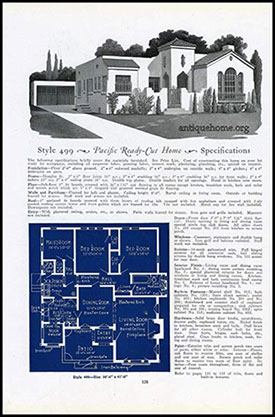
The Aladdin Company in Bay City, Michigan is credited with selling the first kit homes through mail order in 1906. Kit homes – also known as pre-cut houses, mail order homes or catalog homes – were sold by six major companies, and several smaller ones, primarily in the 1910s and 1920s. Major producers included Montgomery Wards and Sears, Roebuck and Company, but Southern California was dominated by Los Angeles-based Pacific Ready-Cut Homes, Inc., which at its peak in the 1920s could produce 25 houses a day at its 24-acre plant, located southeast of Los Angeles near railroad lines from the harbor. From 1908 to 1940, Pacific Ready-Cut Homes sold 37,000 of its "Ready-Cut," ready-to-assemble bungalows, along with schools, real estate offices, bungalow court apartments, gasoline stations, and garages, becoming the third largest industrial producer of housing in the nation. The company eventually had authorized branches in 53 California cities, including Fullerton, but it shipped kit homes as far afield as Mexico, Venezuela, Guatemala, New Zealand, and Japan.
Once ordered, the kit home would be shipped to the site via train or truck, typically arriving in 12,000 or more pieces, accompanied by a thick instruction manual. Onsite, the houses were assembled – not constructed – quickly in three to 30 days, depending upon the size of the home and how many workers were on hand. Today, residents may live in one of these kit homes and not even know it. The most famous kit home in Orange County is the birthplace of former President Richard Nixon, a National Historic Landmark, located on the grounds of the Nixon Presidential Library and Museum in Yorba Linda.
While Fullerton has a few post-World War II manufactured homes produced by short-lived companies, nearly all of the kit homes in the city were purchased from Pacific Ready-Cut. No Sears or Aladdin mail order homes have been identified in Fullerton. Around 1919, Fullerton Home Builders purchased over fifty Pacific Ready-Cut homes to provide much needed housing. Those first kit homes were simple bungalows, but when authorized dealer Clinton F. Abbott opened an office at 112 East Amerige Avenue, homebuyers could select a house from 1,800 different designs – the majority of which were the quintessential one-story California bungalow. Company architects patterned their houses after the popular designs of the day, but the favorite models were Spanish, English Tudor, and Italian in style. Pacific Ready-Cut houses were assembled on lots throughout Fullerton: 426 W. Malvern Avenue; 123 S. Cornell Avenue; 210 N. Berkeley Avenue; 310 N. Adams Avenue; 634 N. Beverly Drive; 209 Buena Vista Drive; 222 and 228 N. Lincoln Avenue; 617 Wesley Drive; 136 N. Yale Avenue, etc. Fullerton's best-known Pacific Ready-Cut home is the Clinton F. Abbott House (715 N. Richman Avenue), a Local Landmark.
When the 1929 crash occurred, Pacific Ready-Cut collapsed as a company, no longer manufacturing precut homes. In the late 1930s, the company, under the management of co-founder William Butte, tried to make a comeback. The company was renamed Pacific System Homes, Inc., running from the late 1930s to the early 1940s. The company was able to manufacture house parts quicker with different materials but was never able to get its mail order house plans approved by the Federal Housing Authority (FHA), which crippled it in the housing market. Fullerton had several Pacific System Homes assembled during the 1930s (e. g., 1224 Luanne Avenue; 1321 Luanne Avenue; 110 North Berkeley Avenue).
The July 2016 issue of the Fullerton Heritage Newsletter has an extensive article on Fullerton kit homes ("Some Assembly Required: Fullerton Kit Homes").
Read more about mail order homes:

Pacific Ready-Cut Homes Catalog
-426W.MalvernAvenue.jpg)
Residence (1921)
426 W. Malvern Avenue
-136N.YaleAvenue.jpg)
Residence (1922)
136 N. Yale Avenue
-123S.CornellAvenue.jpg)
Residence (1927)
123 S. Cornell Avenue
-310N.AdamsAvenue.jpg)
Residence (1929)
310 N. Adams Avenue
-514-516N.MaldenAvenue.jpg)
Duplex (1929)
514-516 N. Malden Avenue
-715N.RichmanAvenue.jpg)
Clinton Abbott House (1929)
715 N. Richman Avenue
-1321N.LuanneAvenue.jpg)
Residence (1937)
1321 Luanne Avenue